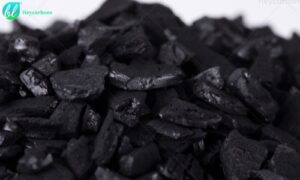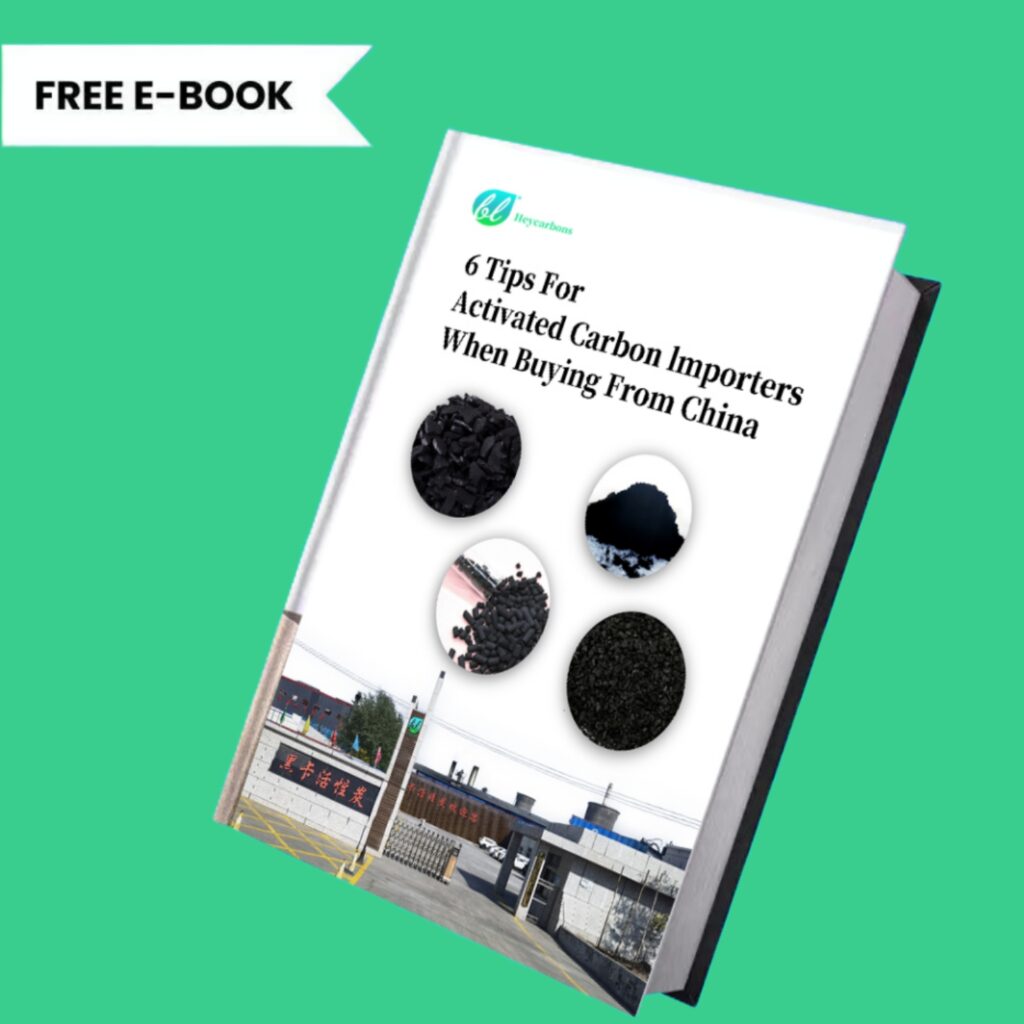Heycarbons: Granular Activated Carbon For Water Treatment Daily Delivery 110t GAC Coal Granular Activated Carbon For Water Treatment to JORDAN
Port: AQABA PORT,JORDAN
Quantity: 110t
Specification:
Size: 8*30mesh
Iodine number: 1000-1050mg/g
Methylene blue: 190mg/g
Moisture content (as packed) – Max. 1-5%
Total ash content : 10-13%
Ball-pen hardness – 95%min
Apparent density – Min. 480 Typical Properties
Features: There are few suppliers who can fully meet the customer’s requirements for high methylene blue, low ash content, high iodine value, and high strength.
We can meet the customer’s needs and deliver more than the customer’s expectations.
1.Introduction to water treatment with coal-based granular activated carbon
Coal-based granular activated carbon is a material with high porosity and specific surface area, which is widely used in the field of water and wastewater treatment. It is especially important in ensuring the safety of drinking water and improving the efficiency of industrial wastewater treatment.
This is because it is very effective and relatively low cost. It is also easily available in large quantities, making it ideal for large wastewater treatment facilities.
Characteristics of Coal Granular Activated Carbon
- Physical Properties
The physical properties of coal granular activated carbon make it an excellent adsorbent. Its pore structure and specific surface area are the key factors determining its adsorption capacity. The pores of activated carbon mainly include micropores, mesopores and macropores, which provide a large amount of surface area and help to adsorb different types of pollutants.
- Pore structure
The pore structure of coal granular activated carbon is very complex and has a high porosity. Micropores are usually used for the adsorption of small organic molecules, while macropores are suitable for the adsorption of larger molecules. This diverse pore structure gives it a high degree of flexibility in removing a wide range of pollutants.
- Specific surface area
The specific surface area is usually in the range of 500-1500 m²/g. A larger specific surface area means a higher adsorption capacity. This enables coal granular activated carbon to remove pollutants quickly and effectively when treating water and wastewater.
- Chemical properties
The chemical properties of coal granular activated carbon also affect its performance in water treatment. Its surface contains a variety of functional groups that can remove pollutants from water by chemical adsorption or ion exchange.
- Adsorption capacity
Coal granular activated carbon has different adsorption capacities for different pollutants. It can effectively remove organic matter, heavy metals, chlorine, ammonia and nitrogen, etc., and at the same time, it has selective adsorption characteristics for specific pollutants. This selectivity makes it perform well in different water treatment applications.
2.Coal granular activated carbon in drinking water treatment
1.Bottled Water Purification
In the production process of bottled water, coal granular activated carbon is not only used to remove odors and organic matter from the water, but also effectively removes microorganisms and pathogens from the water.
The bacterial and viral removal rates of activated carbon are also critical in this process, significantly enhancing the safety of the water.
In addition, the regeneration and replacement cycles of activated carbon are important considerations in bottled water production. With the proper type of activated carbon and operating conditions, efficient water treatment can be achieved and production costs can be reduced.
2.Residual Chlorine Removal
Removal of residual chlorine is not only about water safety, but also about taste and user experience. Coal granular activated carbon can effectively reduce the residual chlorine content in water and improve the taste of water through chemical reaction with chlorine in water.
In addition, the selective adsorption properties of activated carbon enable it to remove a wide range of impurities and pollutants in a targeted manner when treating different water sources.
Combined with other water treatment technologies (e.g., membrane filtration technology and ultraviolet disinfection), it can form an even more efficient integrated treatment system to further enhance water purification.
3.River Water and Rainwater Treatment
In the purification of river water and rainwater, the application of coal granular activated carbon is not limited to physical adsorption. It has been found that activated carbon also has the effect of promoting certain biodegradation processes in water.
For example, activated carbon can be used as a carrier for microorganisms, promoting the formation of biofilms and enhancing the self-purification ability of water bodies.
In rainwater harvesting systems, the use of activated carbon can effectively remove nutrients and pollutants from the water and enhance the quality of rainwater for subsequent utilization.
3.Coal granular activated carbon in industrial wastewater treatment
1.Removal of COD and BOD-coal granular activated carbon wastewater treatment
In industrial wastewater treatment, coal granular activated carbon can remove COD and BOD through a variety of mechanisms.This includes physical adsorption, chemical reaction and biodegradation.
In the case of coexistence of multiple pollutants, activated carbon can selectively adsorb certain pollutants, thus improving the treatment efficiency.
In addition, modification of activated carbon (e.g., by chemical methods) can further enhance its ability to remove specific pollutants and meet the requirements of different industrial sectors.
2. Heavy metal removal-coal granular activated carbon wastewater treatment
The advantages of coal granular activated carbon in the removal of heavy metals are not only reflected in its adsorption capacity, but also in its flexibility in the treatment process.
For example, activated carbon can be combined with other materials, such as modified clays or polymers, to form composite adsorbents to improve removal efficiency and selectivity.
At the same time, the economic and regenerative nature of activated carbon makes it a sustainable application in the treatment of industrial wastewater containing heavy metals. Regular regeneration and use can also significantly reduce the overall cost of wastewater treatment.
4.Coal Granular Activated Carbon in Steam Condensate and Amine Treatment
1. Application of steam condensate
In industrial production, the reuse of steam condensate is an important measure for resource saving. Coal granular activated carbon can effectively clean the impurities in the condensate to meet the reuse standard and reduce the waste of water resources.
By regularly replacing and regenerating the activated carbon, the economy and environmental friendliness of the system can be improved.
In addition, combining other water treatment technologies, such as membrane separation technology, can further improve the purification effect of condensate and make it suitable for a wider range of industrial applications.
2.Amine treatment technology
Coal granular activated carbon also shows superiority in amine treatment. Through the adsorption of amines, it can reduce the harmful components in water and guarantee the safety of water quality.
Specific cases have shown that activated carbon exhibits excellent removal efficiency when treating amine wastewater. With the development of industry and the increasing demand for the treatment of amine pollutants, the application of activated carbon in this field is promising and worthy of further study.
learn more:
5.High activity bituminous coal granular activated carbon
High activity bituminous granular activated carbon is a highly efficient adsorbent material used in a wide range of applications including glycerin decolorization and deodorization, sugar solution treatment, dye penetrant removal, textile wastewater decolorization, solvent recovery, decolorization of inorganic acids and decolorization of citric acid.
Its unique physical and chemical properties make it excellent in removing various types of pollutants.
Specification
- particle size specification: 4×8, 8×30, 8×16, 12×40, 30×60, 80×150
- Iodine value: 500-1050 mg/g
- Specific surface area: 500-1050 m²/g
- Hardness: 90-99%
- Bulk density: 0.45-0.55 g/cm³
- Ash: 6-8%, 8-12%, 12-15
- Moisture: max 5%
- pH value: 8-11
This kind of activated carbon not only has excellent adsorption capacity, but also can maintain stable performance under various environmental conditions. By reasonably selecting the specifications and types, it can meet the needs of different application scenarios and improve the treatment efficiency.
6.Conclusion
The application of coal granular activated carbon in water treatment shows its key role and broad prospect. Whether in drinking water purification or industrial wastewater treatment, activated carbon can provide efficient solutions.
With the development of technology, its application scope and efficiency will continue to improve, making greater contributions to environmental protection and water resources management.
learn more:



